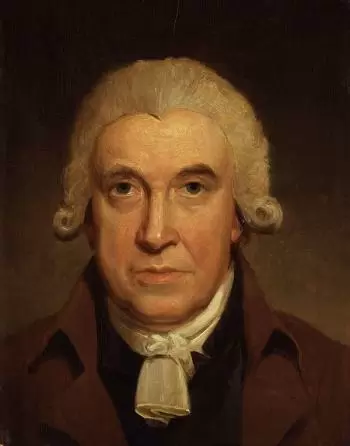
James Watt (Greenock, January 19, 1736 - Handsworth, August 25, 1819) was a Scottish mathematician, engineer, and inventor. Watt's inventions were of great importance for the development of the thermal engine and the steam engine.
Watt invented a control valve (which is still known as regulator "Watt", the centrifugal regulator) to keep constant the speed of the steam engine, he found a way to transform the reciprocating reciprocating movement of the plunger into a movement of continuous rotation of a flywheel. It introduced the "double effect", that is, the steam input alternately at the two ends of the cylinder, to operate the piston in both the forward and return stroke. Finally, he invented the indicator to measure the vapor pressure during the entire work cycle of the engine.
James Watt was of great help in the development of the steam engine, making it a source of exploitable economic power. He understood that the Newcomen machine was wasting almost three quarters of the steam energy in heating the piston and the chamber, and consequently developed a separate condensing chamber, which greatly increased its efficiency. New refinements made the steam engine the work of his life.
The Watt, the unit of measure for the power of the international system of units, bears it by name, as well as, in part, the Heriot-Watt University in Edinburgh.
Biography of James Watt
He was born in Scotland on January 19, 1736 of Presbyterian fathers. His father was an owner, while his mother, Agnes Muirhead, came from a distinguished family. Initially, James Watt was educated at home by his mother, but later attended the engineering school of Greenock, demonstrating great interest in mathematics, although scarce in Greek and Latin.
When James Watt was 18, his mother died and his father's health deteriorated. For these reasons, Watt went to London, settling in the Scottish city of Glasgow, where he attended the university. Here, with the help of three teachers, Watt opened a manufacturing workshop at the university.
James Watt's relationship with the steam engine
In this period he made important friendships with some of the leading exponents of the Scottish scientific community, in particular the link with Joseph Black, who will then introduce the concept of latent heat. In 1764, Watt, observing steam losses in Newcomen machines, developed a capacitor model separate from the cylinder, thus reducing losses. In 1768, with John Roebuck, he built his steam engine model.
In 1772 he moved to Birmingham, where, in 1775, he came into close contact with Matthew Boulton; James Watt tried to commercialize his invention, but the diffusion took place only with the beginning of a thirty-year collaboration with Boulton.
In 1782 James Watt patented the double action machine and the centrifugal force regulator for the automatic control of the machine; Parallelogram articulated in its place, dates back to 1784. In this same period Watt introduced a unit of "power measurement known as" in order to compare the energy produced by steam engines, which is still used today to indicate the power of motor vehicle engines.
In 1785 James Watt was finally invited to join the Royal Society of London. In 1794 he became part of the Lunar Society, from which he retired in 1800. Watt dies in 1819 and his remains are buried in the churchyard of St. Mary's Parish in Handsworth, in the county of the West Midlands.